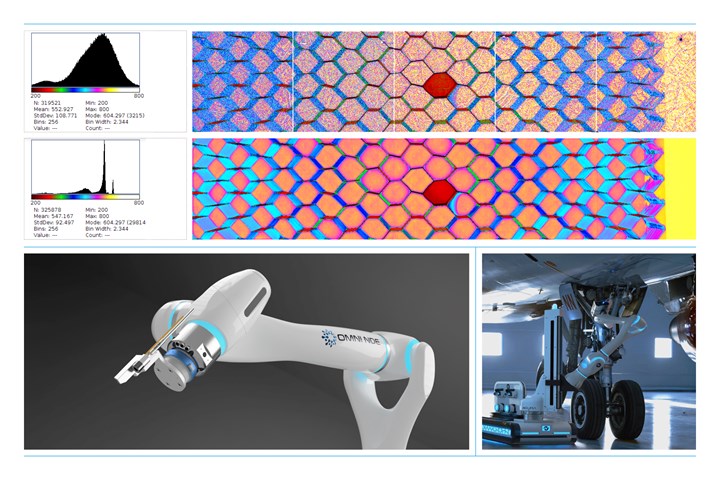Automated NDE equipment brings new inspection capabilities
CAMX 2023: Omni-NDE combines cobots/small robots with novel sensors to provide automated, contactless inspection of composites.
Omni-NDE (Tucson, Ariz, U.S.) features its capabilities in the nondestructive evaluation (NDE) of composites. With decades of experience, Omni-NDE’s technical team brings state-of-the-art medical imaging capabilities — including robotic photon-counting microcomputed tomography (CT) — to advanced materials and manufacturing. Instead of microCT as an expensive service for small- to medium-sized parts, Omni-NDE’s robotic 3D CT enables in-situ scanning, providing a solution for high-growth industries using composite materials.
Omni-NDE is combining novel sensors with software and cobots to provide new inspection capabilities such as in-situ inspection of large structures and fast, contactless, high-resolution scanning and defect measurement for high-attenuation materials. NDE digital twins are also made possible, comprising scans with different sensors (e.g., ultrasound, CT, thermography, shearography) mapped onto a part’s 3D surface.
Omni-NDE uses robots that are said to be smaller and more agile than the traditional industrial robotic inspection cells currently used in composites, offering reduced cost and increased flexibility. NDE sensors and modalities can be easily switched by swapping end effectors, yet are easy to use via a single, intuitive interface.
Omni-NDE is already providing such industry solutions, including measurement of gaps and shims within carbon fiber-reinforced polymer (CFRP) composites and aluminum-stacked structures, quality assurance for ceramic matrix composites (CMC) and in-situ scanning of large space structures. It is also developing automated inspection of bondlines and welded joints, and has already integrated Xarion’s (Vienna, Austria) laser excited acoustics (LEA) sensor for contactless ultrasound with ten times higher resolution than other air-coupled ultrasound technologies, eliminating water and squirter systems for more sustainable NDE operations.
Related Content
-
New brand identity launch aligns with nonwoven portfolio offerings
CAMX 2024: James Cropper, formerly known as Technical Fibre Products, is bringing its new name to the U.S. composites industry, highlighting its specialization in carrier, surface and fire protection veils, among other products.
-
CAMX announces general session presenter, open registration
Attendees registered for the Oct. 31 – Nov. 2, 2023 event in Atlanta, Georgia, are invited to attend this year’s keynote put on by Joan Higginbotham, a former NASA astronaut and president of aerospace consulting firm Joan Higginbotham Ad Astra LLC.
-
Graphene-enhanced SMC boosts molded component properties
CAMX 2023: Commercially sold GrapheneBlack SMC from NanoXplore increases part strength, stiffness and provides other benefits for transportation, renewable energy, energy storage and industrial markets.













